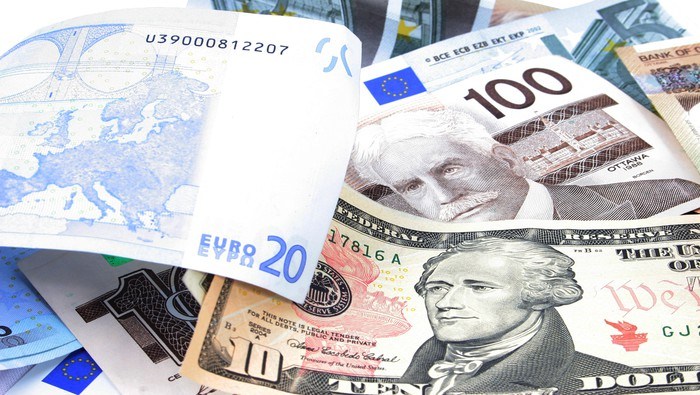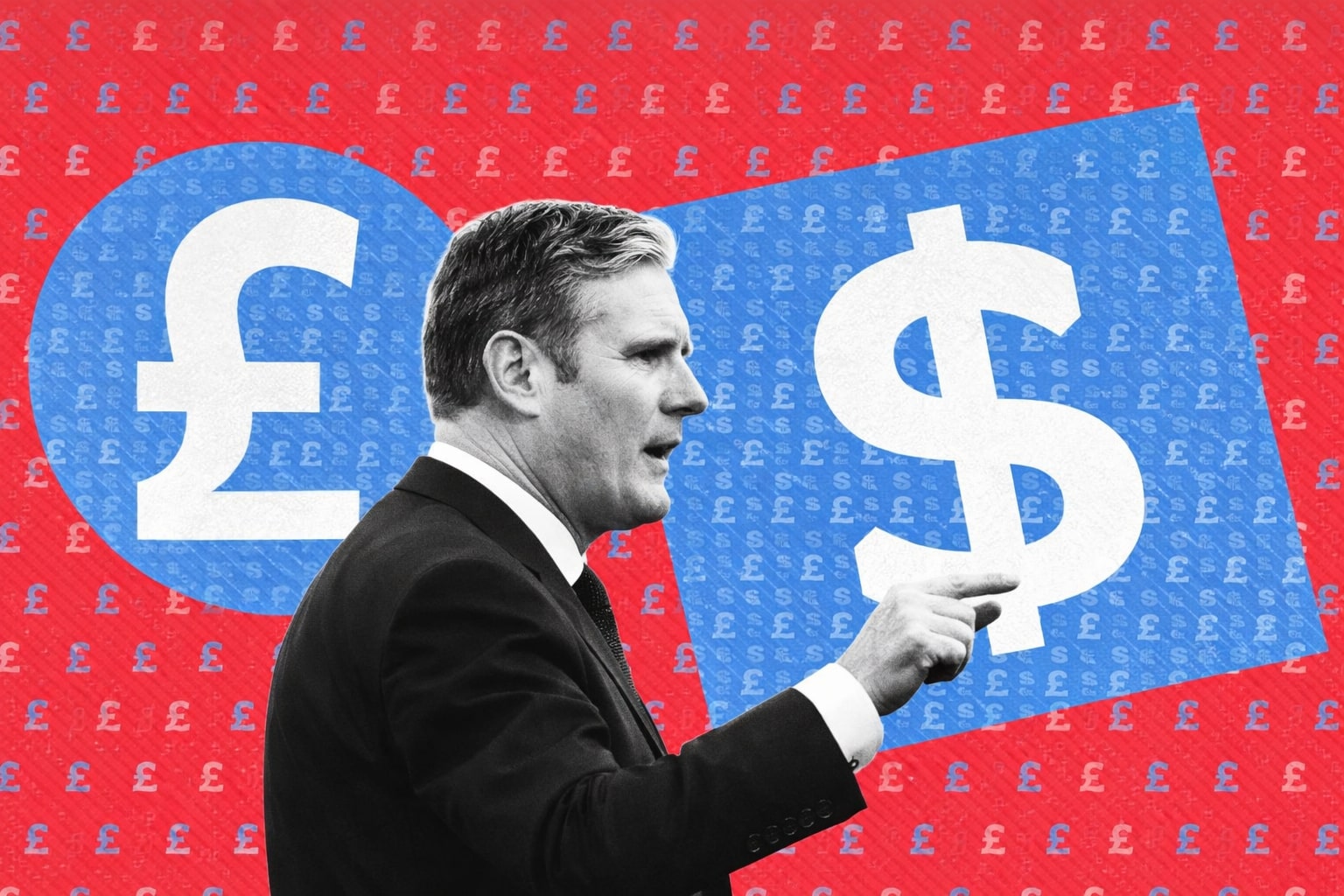
Fluctuations in Currency Landscape: EUR/USD Shows Strength Amid Downturn; USD/CAD Displays Bearish Pattern
Analyzing the Contrasting Trajectories of Key Currency Pairs in a Dynamic Market; Unpacking the Impacts of Central Bank Rhetoric and Macro-Economic Indicators
As global economic phenomena unfold, currency pairs have been experiencing significant fluctuations. Taking a closer look, the EUR/USD pairing experienced a resurgence on Thursday after a severe sell-off previously, bouncing off a strong horizontal support stationed at 1.0640/1.0600. Despite the euro's relatively shaky performance in recent days, the bullish sentiment should not be hastily dismissed. The currency seems to be regaining traction as buyers are re-entering the market, eying a significant resistance point just beneath the 1.0800 psychological mark.
There are two potential scenarios worth considering in the immediate future: the clearance of cluster resistance extending from 1.0750 to 1.0785, and the occurrence of upside exhaustion and rejection from current levels. If buyers successfully push the exchange rate above 1.0750/1.0785, the sentiment could swing favorably, laying the groundwork for a move towards the 50-day simple moving average, currently residing slightly below the 1.0900 level.
On the other hand, USD/JPY rallied significantly in May, fueled by expectations that the Federal Reserve would proceed with rate hikes in the upcoming FOMC meetings. However, sentiments have recently pivoted towards a more dovish direction as some officials have suggested a "pause" to evaluate the delayed effects of past tightening.
From a technical perspective, USD/JPY experienced a setback after it failed to breach the overhead resistance just above the 140.00 psychological mark. Sellers regained control, pushing prices back towards the 138.00 region, the next major support area. If this support level succumbs, bearish sentiments may heighten, potentially leading to an attack on short-term trendline support near 135.90.
Conversely, if USD/JPY pivots upwards and resumes its climb, the initial resistance to monitor is positioned at 140.50/140.90. Successfully navigating above this ceiling could intensify upward momentum, potentially paving the way towards 142.45, representing the 61.8% Fibonacci retracement of the October 2022/January 2023 dip.
The USD/CAD pair also made headlines as it rallied towards its April highs earlier this week but was quickly repelled lower. The pair experienced a sell-off, seemingly carving out the second leg of a double top pattern on Thursday. This pattern is typically recognized as a bearish configuration in technical analysis.
A double top pattern is a reversal pattern often developed during an extended upward move. It comprises two similar peaks separated by an intermediate trough. The setup is confirmed once the price completes its "M" shape and breaks below the neckline, acting as the base for the pattern. In the current scenario, the neckline is located just above the 1.3300 handle. Using the height of the double top pattern and projecting it from the breakpoint, USD/CAD could potentially slump towards 1.2960 in the medium term.
Meanwhile, the European currency continues to face pressure, falling below 1.07 levels twice in two days. Despite the mild bearish environment, the currency has managed to limit losses, with reactions confined to a limited range. It seems to struggle to return to a strong upward trend. However, the hawkish rhetoric from the European Central Bank has somewhat served as an obstacle, preventing the European currency from experiencing severe losses.
In the broader context, disappointing news regarding the progress of the Chinese economy earlier raised concerns in the markets. The level of risk-taking appetite diminished, thereby benefiting the US currency, which typically functions as a safe-haven currency. Despite the turbulence, the European economy continues to have significant macroeconomic announcements on the agenda. This includes the course of inflation in the German economy, which may potentially support or reduce the ECB's aggressive rhetoric.
Last week, the EUR/USD saw a resurgence of strength, bouncing off the horizontal support at 1.0640/1.0600 after a sharp drop. It seemed that the euro's prospects had started to fade, but this reinvigoration shouldn't be ignored. Buyers are returning to the market and appear determined to test a significant resistance level just below the psychologically significant 1.0800 mark.
Going forward, a watchful eye should be kept on the price action and its reaction to key tech zones, as the coming trading sessions will likely shape the short-term directional bias. Two scenarios should be considered: firstly, overcoming the cluster resistance that stretches from 1.0750 to 1.0785, and secondly, a potential burnout of the current upward trend, leading to a rejection from the present levels.
If buyers drive the exchange rate above the aforementioned resistance range, the sentiment could change for the better. This could set the stage for a move towards the 50-day simple moving average, currently slightly below the 1.0900 handle. However, if sellers initiate a bearish reversal, the EUR/USD may soon find itself heading back to test its May lows.
Meanwhile, the USD/JPY pair rallied in May, underpinned by expectations that the Fed would continue hiking rates at the upcoming FOMC meetings. However, the sentiment took a dovish turn recently after some officials advocated for a "pause" to assess the delayed effects of previous tightening measures. This shift in expectations led markets to largely discount the likelihood of a 25 bp hike in June, resulting in a pullback in the U.S. dollar.
Upon a technical analysis standpoint, the USD/JPY started to retrench after it failed to clear overhead resistance situated just above the psychological 140.00 mark. From that point, sellers reclaimed control, pushing prices back towards the 138.00 area – the next significant support. If this support level gives way in the upcoming sessions, bears might muster the confidence to target the short-term trendline support near 135.90.
However, if USD/JPY finds footing and resumes its ascent, the first resistance to monitor is at 140.50/140.90. If it successfully navigates above this hurdle, it could bolster the upward momentum, paving the way for a climb towards 142.45, which is the 61.8% Fibonacci retracement of the October 2022/January 2023 decline.
In other currency developments, USD/CAD rallied towards its April highs early in the week, but this upward trend was swiftly countered, leading to a sell-off that appears to be forming the second leg of a double top pattern – a bearish formation as per technical analysis standards. A double top is a reversal pattern that often occurs after a prolonged upward move, composed of two similar peaks separated by a moderate trough. The pattern is confirmed once the price completes its “M” shape and breaks below the neckline, which acts as a base for the pattern. In the present scenario, the neckline is slightly above the 1.3300 handle.
The probable size of the downward movement can be calculated by projecting the height of the double top from the breakpoint vertically. For USD/CAD, this could indicate a potential fall toward 1.2960 over a medium-term horizon.
The European currency found itself struggling on Wednesday as it slipped below the 1.07 levels for a second time in two days. The exchange rate behavior confirmed the sentiment expressed in a previous analysis. Although the European currency faced mild pressure, making new local lows at the 1.0670 level, it swiftly rallied back above 1.07. Yet, for now, the European currency seems to be merely
holding on, with any bullish reactions being confined to a relatively narrow range. The consistent bearish pressure and inability to make a decisive push higher may point to underlying weakness in the currency.
The somewhat hawkish stance of the European Central Bank has been helping to keep the currency from freefalling. The ECB's positive tone has added some support to the European currency, preventing it from experiencing a steep decline despite the persistent bearish pressures.
Over the last few days, the financial markets were also rattled by discouraging news about the Chinese economy, which caused an overall decrease in risk appetite. As a result, the U.S. dollar, typically seen as a safe-haven currency, was able to benefit from this shift in sentiment.
Despite the turbulence, the European economy continues to have key macroeconomic indicators on its radar. This includes the inflation rate in Germany, which will be a key factor influencing the ECB's monetary policy stance. The release of this data could either support the ECB's hawkish rhetoric or possibly temper it, depending on the inflation trajectory.
Also worth noting is the USD/CAD pair, which continues to capture attention due to its recent performance. After rallying towards its April highs earlier in the week, the pair experienced a sell-off, forming what appears to be the second leg of a double top pattern. This pattern is typically considered bearish in technical analysis.
The double top pattern typically forms during an extended upward move and consists of two similar peaks separated by a trough. The pattern is confirmed once the price completes its "M" shape and breaks below the neckline, which acts as the pattern's base. In the case of USD/CAD, the neckline sits just above the 1.3300 mark. If the price breaks below this level, it could potentially trigger a significant sell-off, with the pair potentially dropping towards the 1.2960 level over the medium term.
Read More
-
AMD Stock Price Forecast - AMD at $223: AI GPU Ramp, CES 2026 Catalysts and the Next Move for NASDAQ:AMD
03.01.2026 · TradingNEWS ArchiveStocks
-
XRP Price Forecast - XRP-USD Near $2 as Whales Add $3.6B and ETF Inflows Top $1.18B
03.01.2026 · TradingNEWS ArchiveCrypto
-
Oil Price Forecast: Oil Near $60 Weigh Venezuela Shock Against 3.8M bpd Glut
03.01.2026 · TradingNEWS ArchiveCommodities
-
Stock Market Today - Wall Street Opens 2026; Dow 48,382, S&P 6,858 on Chip Rally, Gold Boom and Bitcoin $90K
03.01.2026 · TradingNEWS ArchiveMarkets
-
GBP/USD Price Forecast - Pound Tests 1.35 as BoE Caution Meets Soft US Dollar
03.01.2026 · TradingNEWS ArchiveForex


















